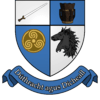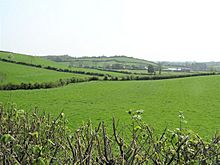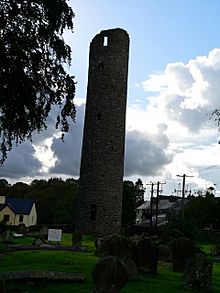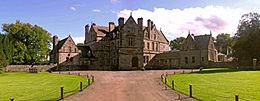County Monaghan facts for kids
Quick facts for kids
County Monaghan
Contae Mhuineacháin
|
||
|---|---|---|
|
||
| Nickname(s):
The Drumlin County
|
||
| Motto(s): | ||
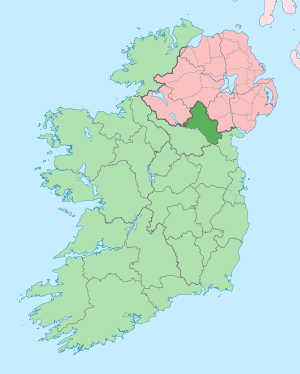 |
||
| Country | Ireland | |
| Province | Ulster | |
| Established | 1607 | |
| County town | Monaghan | |
| Government | ||
| • Type | County Council | |
| Area | ||
| • Total | 1,295 km2 (500 sq mi) | |
| Area rank | 28th | |
| Highest elevation
(Slieve Beagh)
|
373 m (1,224 ft) | |
| Population
(2016)
|
||
| • Total | 61,386 | |
| • Rank | 28th | |
| • Density | 47.402/km2 (122.77/sq mi) | |
| Time zone | UTC±0 (WET) | |
| • Summer (DST) | UTC+1 (IST) | |
| Eircode routing keys |
A75, A81, H18, H23 (primarily)
|
|
| Telephone area codes | 047 (primarily) | |
| Vehicle index mark code |
MN | |
County Monaghan ( mon-Ə-hən; Irish: Contae Mhuineacháin) is a county in Ireland. It is part of the Border Region and is in the province of Ulster. It is named after the town of Monaghan. Monaghan County Council is the local authority for the county. The population of the county was 61,386 according to the 2016 census.
The county has existed since 1585, when the Mac Mathghamhna rulers of Airgíalla agreed to join the Kingdom of Ireland. Following the 20th-century Irish War of Independence and the signing of the Anglo-Irish Treaty, Monaghan was one of three Ulster counties to join the Irish Free State rather than Northern Ireland.
Contents
Geography and political subdivisions
Monaghan is the fifth smallest of the Republic's 26 counties in area and fourth smallest by population. It is the smallest of Ulster's nine counties in size and also the smallest in terms of population.
Baronies
- Cremorne (Irish: Críoch Mhúrn)
- Dartree (Irish: Dartraighe)
- Farney (Irish: Fearnaigh)
- Monaghan (Irish: Muineachán)
- Trough (Irish: An Triúcha)
Civil parishes and townlands
Towns and villages
| Historical population | ||
|---|---|---|
| Year | Pop. | ±% |
| 1600 | 2,988 | — |
| 1610 | 4,663 | +56.1% |
| 1653 | 5,801 | +24.4% |
| 1659 | 9,734 | +67.8% |
| 1821 | 174,697 | +1694.7% |
| 1831 | 195,536 | +11.9% |
| 1841 | 200,442 | +2.5% |
| 1851 | 141,823 | −29.2% |
| 1861 | 126,482 | −10.8% |
| 1871 | 114,969 | −9.1% |
| 1881 | 102,748 | −10.6% |
| 1891 | 86,206 | −16.1% |
| 1901 | 74,611 | −13.5% |
| 1911 | 71,455 | −4.2% |
| 1926 | 65,131 | −8.9% |
| 1936 | 61,289 | −5.9% |
| 1946 | 57,215 | −6.6% |
| 1951 | 55,345 | −3.3% |
| 1956 | 52,064 | −5.9% |
| 1961 | 47,088 | −9.6% |
| 1966 | 45,732 | −2.9% |
| 1971 | 46,242 | +1.1% |
| 1979 | 50,376 | +8.9% |
| 1981 | 51,192 | +1.6% |
| 1986 | 52,379 | +2.3% |
| 1991 | 51,293 | −2.1% |
| 1996 | 51,313 | +0.0% |
| 2002 | 52,593 | +2.5% |
| 2006 | 55,997 | +6.5% |
| 2011 | 60,483 | +8.0% |
| 2016 | 61,273 | +1.3% |
- Ballinode
- Ballybay
- Carrickmacross
- Castleblayney
- Clones
- Doohamlet
- Emyvale
- Inniskeen
- Glaslough
- Killanny
- Knockatallon
- Magheracloone
- Monaghan
- Newbliss
- Oram
- Rockcorry
- Scotshouse
- Scotstown
- Smithborough
- Threemilehouse
- Tydavnet
- Tyholland
- Truagh
- Latton
Largest Towns in County Monaghan (2011 Census)
1. Monaghan = 7,452
2. Carrickmacross = 4,925
3. Castleblayney = 3,634
4. Clones = 1,761
5. Ballybay = 1,461
Geography
Notable mountains include Slieve Beagh (on the Tyrone and Fermanagh borders), Mullyash Mountain and Coolberrin Hill (214 m, 702 ft). Lakes include Lough Avaghon, Dromore Lough, Drumlona Lough, Lough Egish, Emy Lough, Lough Fea, Inner Lough (in Dartrey Forest), Muckno Lough and White Lough. Notable rivers include the River Fane (along the Louth border), the River Glyde (along the Louth and Meath borders), the Ulster Blackwater (along the Tyrone border) and the Dromore River (along the Cavan border, linking Cootehill to Ballybay).
Monaghan has a number of forests, including Rossmore Forest and Dartrey Forest. Managed by Coillte since 1988, the majority of trees are conifers. Due to a long history of intensive farming and recent intensive forestry practices, only small pockets of native woodland remain.
The Finn Bridge is a border crossing point over the River Finn to County Fermanagh. It is close to Scotshouse.
Geology
Lead was formerly mined in County Monaghan. Mines included Annaglogh Lead Mines and Lisdrumgormley Lead Mines.
History
In 1585, the English lord deputy of Ireland, Sir John Perrot, visited the area and met the Irish chieftains. They requested that Ulster be divided into counties and land in the kingdom of Airgíalla be apportioned to each of the McMahon chiefs. A commission was established to accomplish this and County Monaghan came into being. The county was subdivided into five baronies: Farney, Cremorne, Dartrey, Monaghan and Truagh, which was left under the control of the McKenna chieftains.
After the defeat of the rebellion of Hugh O'Neill, The O'Neill and the Ulster chieftains in 1603, the county was not planted like the other counties of Ulster. The lands were instead left in the hands of the native chieftains. In the Irish Rebellion of 1641 the McMahons and their allies joined the general rebellion of Irish Catholics. Following their defeat, some colonisation of the county took place with Scottish and English families.
Inland waterways
County Monaghan is traversed by the derelict Ulster Canal, however Waterways Ireland are embarking on a scheme to reopen the canal from Lough Erne into Clones.
Culture and architecture
County Monaghan is the birthplace of the poet and writer Patrick Kavanagh, who based much of his work in the county. Kavanagh is one of the most significant figures in 20th-century Irish poetry. The poems "Stony Grey Soil" and "Shancoduff" refer to the county.
Monaghan has produced several successful artists. Chief among these is George Collie (1904–75), who was born in Carrickmacross and trained at the Dublin Metropolitan School of Art. He was a prolific exhibitor at the Royal Hibernian Academy throughout his lifetime and is represented by works in the collection of the National Gallery of Ireland and the Ulster Museum.
Monaghan was also the home county of the Irish writer Sir Shane Leslie (1885–1971), 3rd Baronet of Glaslough, who lived at Castle Leslie in the north-east corner of the county. A Catholic convert, Irish nationalist and first cousin of Winston Churchill, Prime Minister of the United Kingdom, Leslie became an important literary figure in the early 1900s. He was a close friend of many politicians and writers of the day including the American novelist F. Scott Fitzgerald (1896–1940), who dedicated his second novel, The Beautiful and Damned, to Leslie.
Monaghan County Museum is recognised as one of the leading provincial museums in Ireland, with a Council of Europe Award (1980), among others, to its credit. Located in Hill Street, Monaghan Town, the museum aims to reflect the history of Co. Monaghan and its people in all its richness and diversity.
The best of the county's architecture developed in the Georgian and Victorian periods and ranges from the dignified public spaces of Church Square and The Diamond in Monaghan Town to the great country houses of Lough Fea, Carrickmacross; Hilton Park, Clones and Castle Leslie, Glaslough.
Significant ecclesiastical buildings include St Joseph's Roman Catholic Church, Carrickmacross, which houses a set of stained glass windows by the Irish artist Harry Clarke (1889–1931); the Gothic-Revival St Patrick's Church of Ireland, Monaghan town; and the impressive St Macartan's Roman Catholic Cathedral, Monaghan town, by J. J. McCarthy (1817–1882).
Notable Monaghan people
Literature and scholarship
- Patrick Kavanagh (21 October 1904 – 30 November 1967) - Poet.
- Patrick McCabe - Novelist and member of Aosdána. Born 1955.
- Eugene McCabe - Playwright, novelist and screenwriter, also member of Aosdána. Born 1930, lives in Clones.
- Sir Shane Leslie, 3rd Bt (1885–1971) - Writer and political activist, 3rd Baronet of Glaslough and first-cousin of Sir Winston Churchill. Resided at Castle Leslie.
- Evelyn Shirley (1812–1882) - Writer and antiquarian. Resided at Lough Fea House near Carrickmacross.
- John Robert Gregg (1867–1948) - Pioneer of modern shorthand writing.
- Sir Tyrone Guthrie (1900–1971) - Writer, theatrical director and founder of the Tyrone Guthrie Centre. Born in Royal Tunbridge Wells, his maternal grandmother was from Newbliss. He settled at Annaghmakerrig House in Co. Monaghan late in his life.
Sport
- Dame Mary Bailey (1890–1960), aviator who was the daughter of The 5th Baron Rossmore and wife of Sir Abe Bailey, the South African 'Randlord'.
- Barry McGuigan, world Boxing Champion 1985. Born in Clones 28 February 1960.
- Tommy Bowe, Rugby Union player, born in Monaghan town, 22 February 1984.
- James Cecil Parke (1881–1946), Tennis and rugby player. Olympic silver medalist in tennis, twice winner of the Wimbledon Mixed Doubles title and Australian Men's Singles title winner. Captain of the Irish rugby team
- Kevin McBride, Olympic Boxer
- John McKenna (1855–1936), the first manager of Liverpool Football Club along with W.E. Barclay.
Music and entertainment
- "Big Tom" McBride, country Singer
- Oliver Callan, satirist and mimic, born in the county in December 1980.
- The Flaws, indie Rock Band from Carrickmacross.
- Ryan Sheridan, singer and guitarist
- Terry Cavanagh, video game designer
Acting
- Caitriona Balfe, fashion model and actress
- Ardal O'Hanlon, actor and comedian
- Charlene McKenna, actress
- Aoibhinn McGinnity, actress
Art
- Alexander Williams (1846–1930), Artist, born in Monaghan town.
Religion
- Dr John Darley (1799–1884), Church of Ireland Lord Bishop of Kilmore, Elphin and Ardagh, 1874–84.
- George Jeffreys (1889–1962), Welsh founder of the Elim Pentecostal Church, which was first established in Monaghan town in 1915. The movement now has some 9,000 churches worldwide.
Twin cities
County Monaghan is twinned with the following places:
 Geel, Flanders, Belgium
Geel, Flanders, Belgium Prince Edward Island, Canada
Prince Edward Island, Canada Miramichi, New Brunswick, Canada
Miramichi, New Brunswick, Canada Peterborough, Ontario, Canada
Peterborough, Ontario, Canada
Economy
Agriculture is a significant part of the County Monaghan economy, employing about 12% of the population in 2011 (compared with 5% nationally). The county is the main source of egg supplies in the Republic of Ireland.
See also
 In Spanish: Condado de Monaghan para niños
In Spanish: Condado de Monaghan para niños


